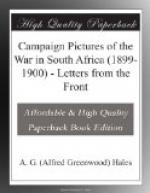On most of the farms a small orchard is found enclosed in stone walls. Here again the ignorance of the Boers is very marked; the fruit is of poor quality, though the variety is large. Thus, one finds in these orchards pears, apples, grapes, plums, pomegranates, peaches, quinces, apricots, and almonds. The fruit is harsh, small, and flavourless, owing to bad pruning, want of proper manure, and good husbandry generally. The Boer seems to think that he has done all that is required of him when he has planted a tree; all that follows he leaves to nature, and he would much rather sit down and pray for a beautiful harvest than get up and work for it. He is a great believer in the power of prayer. He prays for a good crop of fruit; if it comes he exalts himself and takes all the credit; if the crop fails he folds his hands and remarks that it was God’s will that things should so come to pass. He knocks all the work he can out of his niggers, but does precious little himself. In stature he is mostly tall, thin, and active. He moves with a quick, shuffling gait, which is almost noiseless. Some of his women folk are beautiful, while others are fat and clumsy, and are never likely to have their portraits hung on the walls of the Royal Academy.
A prisoner of war.
Bloemfonteinhospital.
I little fancied when I sat at my ease in my tent in the British camp that my next epistle would be written from a hospital as a prisoner, but such is the case, and, after all, I am far more inclined to be thankful than to growl at my luck. Let me tell the story, for it is typical of this peculiar country, and still more peculiar war. I had been writing far into the night, and had left the letter ready for post next day. Then, with a clear conscience, I threw myself on my blankets, satisfied that I was ready for what might happen next. Things were going to happen, but though the night was big with fate there was no warning to me in the whispering wind. Some men would have heard all sorts of sounds on such a night, but I am not built that way I suppose. Anyway, I heard nothing until, half an hour before dawn, a voice jarred my ear with the news that “there was something on, and I’d better fly round pretty sharp if I did not mean to miss it.”




